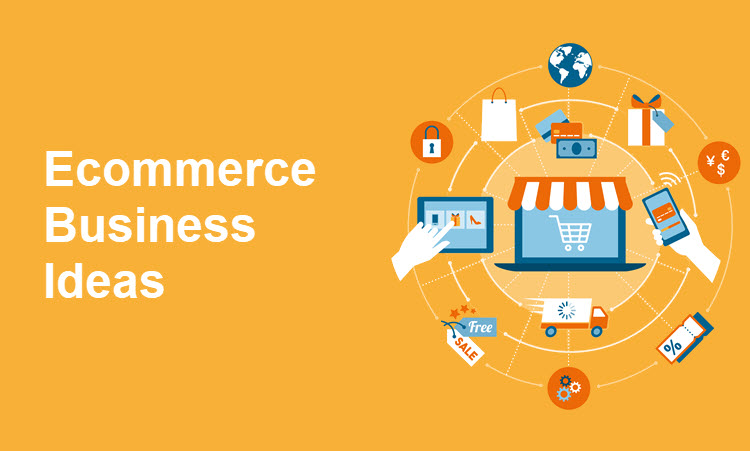The global ecommerce market keeps developing quickly, connecting merchants into a unified shopping environment.
As reported by Statista, in 2022 ecommerce revenue will reach $875.2 billion in the US alone, possibly surpassing $1,300 billion by 2025. According to the same source, by the end of 2022 global ecommerce sales will have exceeded $5.5 trillion.
This means that there are many opportunities out there for merchants to grab a portion of increasing ecommerce revenue.
This article presents 19 ecommerce business ideas that can bring big profits in 2023.
Ecommerce Business Ideas
When launching an ecommerce enterprise, it is important to start something that is likely to bring profits from day one. Waiting too long for your business to start generating income leads to anxiety, dissatisfaction, and eventually financial loss.
With that in mind, we have prepared a list of ideas for ecommerce businesses that can potentially start yielding revenue right from the start.
1. Affiliate Marketing

Affiliate marketing is a business model in which a brand pays third-party entities (affiliates) to recommend and promote its products or services via blogs, social media, business websites, email, and other channels.
An affiliate shares the brand’s referral links or codes on multiple channels. When a customer uses that referral link or code to buy certain items from the brand in question, the affiliate gets a commission.
It’s crucial to find a reliable and practical affiliate program that allows all interested parties to track completed purchases and identify recurring customers. It is also essential to monitor how many clicks a product link gets to be able to offer the right products to the right audience and withdraw the items that don’t bring profits.
Pros: Low launch costs and low business risk.
Cons: Not possible to influence or change pricing models.
Note: Refer to our in-depth guide to learn everything there is to know about how to start an ecommerce business.
2. Dropshipping

Launching an e-store has become much simpler thanks to dropshipping.
In this ecommerce business model, merchants sell items and services produced by a third party. The manufacturer provides the product or service, they deal with storage, shipping, delivery tracking, inventory management, and other necessary actions. The ecommerce merchant sells the product, without having to trouble with these background responsibilities.
Since merchants don’t stock the physical products, they don’t need a warehouse. This means lower cash risk and overall inventory costs. However, for this business model to work, a dropshipper needs a reliable supplier and relevant products.
Pros: No need for a warehouse, hence, lower operational costs.
Cons: Lack of control over the quality of products and shipping times.
3. Develop a Niche Product

A niche product is a specific item aimed at a particular market segment. Merchants choose a niche based on the product’s price and quality, as well as on the demographic, location, and social status of the target audience.
Developing a niche product and building an e-business around it could bring more profits than selling dozens of different items. An online business selling only pet food is an example of a store providing niche products.
Choose several potential niche products and conduct research within the target geographical area to see whether there’s business potential. Once you identify the right niche product, start producing it and offering items for sale.
Pros: The right niche product can bring a substantial income within a relatively short time.
Cons: The research to identify the right product might take more time than expected.
Note: Refer to our article on product ideas to help you with your brainstorming for the new business.
4. Provide Creative Services

Creative services encompass marketing, entertainment, and design, including their subgroups, such as branding or UX design.
Today, every company needs such services to increase its visibility in the digital environment. The competition has never been fiercer so it has become essential to ensure a continuous social media presence. This is where digital media marketing and social media companies come on stage.
Also, content is more important than ever before. From blog posts and how-to guides to website copy and technical writing, companies need various content forms. This makes writing services another potentially profitable business idea.
Pros: There’s high demand for creative services in the online business world.
Cons: It can be difficult to calculate or negotiate the value of creative services.
5. Launch a Voiceover Business

Explainer videos, promotional clips, YouTube commercials, audiobooks, and online courses are only some of the materials that can be voiced over.
What’s important here is to build a reliable voiceover brand that produces outstanding material. Be aware that it might take a while before you land enough clients to run a full-scale company.
For starters, get the right equipment and use the power of social commerce to promote your business, attract clients, and start charging for your voiceover services. To stand out from the crowd, offer voiceovers in several languages.
Pros: With a reasonable number of clients, you can make substantial profits from the comfort of your home-based voiceover studio.
Cons: The voiceover industry recognizes only top technical quality, meaning that the sound and content must be impeccable. This level might be difficult to achieve.
6. Make Natural Products

All around the world, people have developed ecological awareness. In the previous decade, the global revenue from natural and organic cosmetics has almost doubled: from $6.1 billion in 2012 to $11.9 billion in 2022.
Hygienic products, such as soaps and shower gels, beauty products, and cleaning liquids are only some examples of potentially profitable natural products. Another option is to merge a niche product and natural products to micro-target a specific audience.
Make sure to offer alternative payment methods so that buyers from different locations can purchase your goods.
Pros: A growing market with buyers from different parts of the world.
Cons: The production costs might not be easy to gauge in the beginning.
7. Handcrafted Items

Buyers generally appreciate handmade items, so connecting ecommerce and handmade products can result in significant business growth and substantial profits.
However, don’t take your potential customers for granted. It’s essential to determine the unique selling proposition (USP) that will attract them in the first place. Identify the key features of your products or services that make them better than your rivals’. For instance, making jewelry from natural or recycled materials could be a USP.
Consider selling handcrafted items on Etsy, Craigslist or domestic alternatives to these platforms. As your profits grow, save money to launch your own website.
Pros: Buyers generally appreciate and purchase handmade items.
Cons: It takes time to learn how to make outstanding handcrafted items.
8. Sell Cosmetic Products

Selling cosmetic products online has become popular in the last few years. Merchants can target a wider audience with cosmetic goods as it is not unusual to order a face lotion or skincare products from another country. People like buying exotic cosmetic products, which make them feel special and unique. If such products have a healing or comforting effect, even better.
Pros: Globally, there’s a relatively high demand for cosmetic products.
Cons: Mind the expiration dates.
9. Initiate an eLearning Platform

This is the age of lifelong education and online learning. Far-sighted entrepreneurs recognize the perfect business opportunity in e-learning platforms.
Depending on the niche, there are different available options. Think about initiating an e-learning platform for professionals from your industry to help them improve their professional output. This saves assets because you can use in-house materials for the courses and share the knowledge you already possess.
Another option is to launch an e-learning platform in a niche that is guaranteed to attract attendees. A language-learning app is such a platform.
Pros: There is a huge global audience ready to pay for online courses.
Cons: Preparing materials can be time-consuming and expensive.
10. Provide Subscription Boxes

Subscription boxes are theme-based packages that contain various items: food, beauty products, home items, office supplies, etc. You don’t make these products on your own. Instead, you connect with brands and craftspeople to buy, pack, and sell their products.
It’s essential to provide high-quality and appealing products. Enterprising merchants explore a wide variety of goods and services customers will be keen to purchase.
Pros: Subscription boxes offer B2B opportunities as they can be offered to businesses as well as retail buyers.
Cons: Return policies can be difficult to establish. Merchants need to bear this in mind to avoid excessive chargebacks.
11. Offer Technical Services

Providing technical services is a way to capitalize on your technical knowledge. For instance, web hosting, coding or app testing are sought-after services and can become a profitable asset.
One option is to start a business that can provide simpler IT services. Large companies can outsource their services to your venture, providing you with a continuous cash flow. As the number of clients grows, consider hiring additional employees. Eventually, your company could become large enough to outsource non-core tasks.
Pros: No need for manufacturing, storing or shipping specific products.
Cons: Finding clients that would accept your outsourcing services is not always easy.
12. Launch a Software as a Service (SaaS)

Software as a Service (SaaS) is the present and future of ecommerce. Instead of paying for expensive software licenses, companies and individuals opt for SaaS services. Companies like this model because of its scalability. They can choose from several pricing tiers and packages, in line with their current needs. If they need additional elements, they upgrade to a higher package. Conversely, they subscribe to a lower tier if they need fewer features.
Merchants launching a SaaS subscription model can get familiar with SaaS billing to collect subscribers’ payments quickly and effectively, without manual invoicing.
Pros: Merchants can offer customizable packages and quickly adapt to market changes.
Cons: Forming pricing tiers and defining their elements is not simple.
13. Sell Smartwatches

Around 22 million smartwatches were sold in the US in 2020, which is a significant increase from 9 million items in 2016. Since sales are projected to keep growing, selling smartwatches can bring big profits.
The greatest potential of these wearables lies in their omnipresence. From work schedules and fitness activities to GPS tracking and practical daily uses (e.g., checking up on or calling your kid after school), smartwatches make people’s everyday life more comfortable. Everyone could use a smartwatch, regardless of their age.
Pros: There’s a huge potential market share for these products.
Cons: Not every manufacturer is equally reliable so buy smartwatches from trustworthy sources.
14. Provide Subscription Services

Subscription-based businesses have taken the business world by storm. From retail products, like the above-mentioned subscription boxes, to digital content and web-based services, many items and services are available via subscription.
Merchants using this business model can count on recurring payments, which helps them calculate their budgets more accurately. Business owners only need to decide whether they’ll offer both monthly and annual subscriptions or only one of these two models. Also, they might want to provide certain content for free and limit access to premium content with paywalls, especially for digital subscriptions.
Pros: Subscriptions ensure predictable revenue, prevent churn and make business planning easier.
Cons: Potentially high cancellation rate because of the no-strings-attached nature of this model.
15. Start Video Streaming

Video content monetization has become a profitable business in the last decade. For instance, game streaming, educational materials, or live videos broadcast via social media platforms attract thousands of viewers and generate long-term followers.
When a video content creator finds a sponsor, they can also add their links to the stream and make money from ads. Another option is to invite fans to contribute with recurring donations if they’re happy with the content. As those symbolic payments pile up, the revenue increases.
Pros: If you’re already into gaming or vlogging, monetizing what you’re already doing requires little additional effort.
Cons: Producing livestream content can be physically and mentally demanding.
16. Provide Captioning and Transcription Services

YouTube videos, audio and video business materials, social media stories and images are some of the content for which businesses can create captioning and transcription.
The continuous growth of the mobile market means that there will be an even greater demand for captions and transcriptions in the future. Namely, mobile users often can’t or don’t want to play the sound on videos.
Think about finding your first couple of clients via freelance platforms, such as Upwork. When you have enough clients, you can launch a full-fledged business.
Pros: Captioning and transcription services don’t require any additional education.
Cons: Building a network of long-term clients takes time and assets.
17. Start a Podcast

Podcasting is one of the fastest-growing digital industries in the US, with more than 120 million active podcast listeners in 2021.
As podcasts become more popular worldwide, starting a podcast is a wise and potentially profitable business idea.
Be aware that you need high-end equipment to bring a clear sound to your listeners. This means investing in a good microphone, as well as audio-recording hardware and software. There are many other podcasters out there, trying to do the same, so the final result must stand out.
Think about potential guests in your podcasts, with the target audience in mind. There are different types of podcasts, from sports and political programs to business and lifestyle. Find your niche and focus on successful people in that segment.
Pros: The golden time of podcasts is yet to come, meaning that profits are only going to grow.
Cons: It might be tricky to convince influential professionals to be your guests.
18. Start Selling Face Masks

The coronavirus pandemic created a boom in face mask sales. The product is likely to remain in demand.
Even when the threat of COVID-19 subsides, a certain number of people will continue wearing masks in potentially risky situations. So, selling face masks is a profitable ecommerce idea for the future.
Find a reliable supplier that produces medically approved masks and negotiate the terms and conditions of your collaboration.
Since masks are often purchased in bulks, think about pricing in advance. Consider applying volume pricing and giving discounts for larger orders to attract more customers and ensure a regular cash flow.
Pros: The mask-production process isn’t expensive, meaning that the return on investment (ROI) is relatively high.
Cons: Consider the oscillations in revenue since people wear face masks more in the fall and winter.
19. Offer Meal Delivery Services

Meal delivery services are likely to ensure a decent revenue in the time to come. There are two main reasons for this trend.
Firstly, many people have realized that cooking wastes a lot of time, and ordering food online often costs the same as preparing lunch at home.
Secondly, eating out often wasn’t possible during the pandemic, and people got into the habit of ordering food to enjoy at home.
When launching a meal delivery business, make a business website and mobile app to cover different segments of potential users.
Remember that you’ll be competing with experienced food delivery names. Therefore, try to come up with innovative delivery ideas, such as using electric scooters for fast and cheap delivery, or similar concepts.
Pros: This is a growing market, with numerous opportunities for advancement.
Cons: Food delivery needs to be fast. Otherwise, it won’t be profitable.
Conclusion
Ecommerce offers numerous opportunities for ambitious and innovative merchants.
Before you start ordering, producing, or selling items, check if people are interested in your goods. If not, keep testing the market and offering different products and services until you hit the bull’s eye. With the right ecommerce idea, you will be able to develop your business and make a fine profit.
The ecommerce business ideas presented above will help you choose one or perhaps combine several options to develop a lucrative business that will keep making money for a long time.
